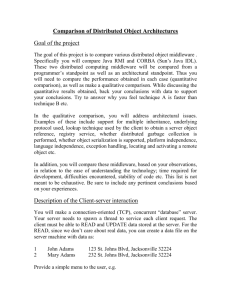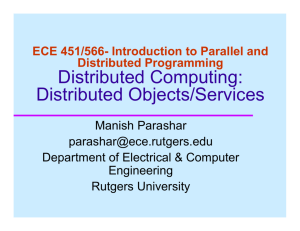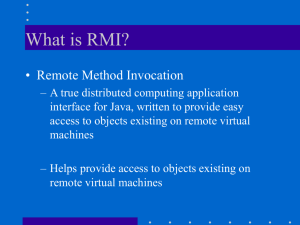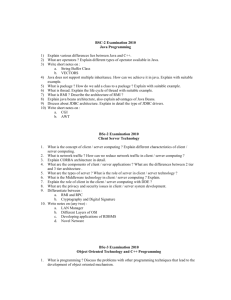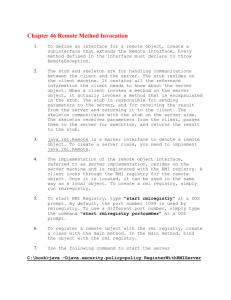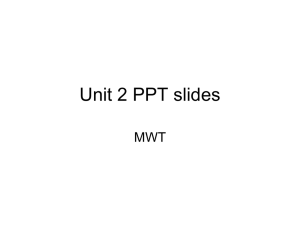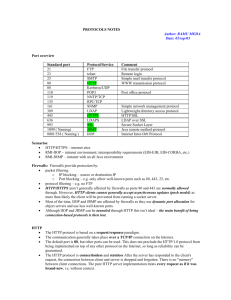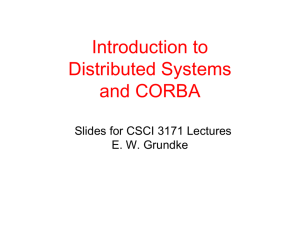Corba & RMI
advertisement
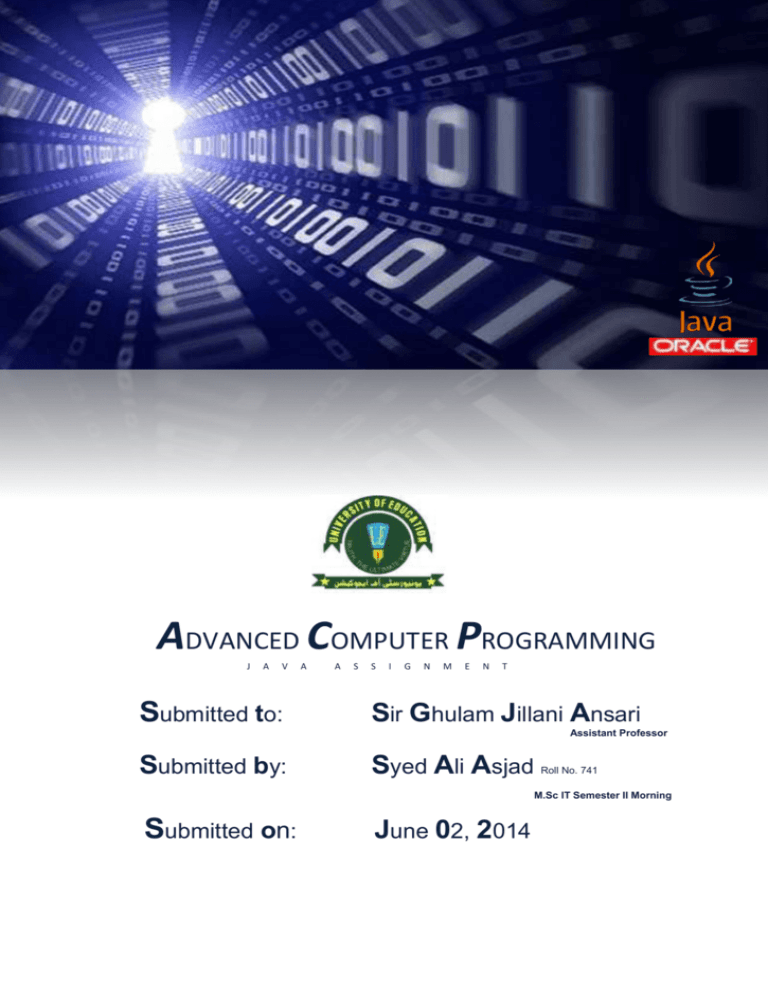
ADVANCED COMPUTER PROGRAMMING J A V Submitted to: A A S S I G N M E N T Sir Ghulam Jillani Ansari Assistant Professor Submitted by: Syed Ali Asjad Roll No. 741 M.Sc IT Semester II Morning Submitted on: June 02, 2014 CORBA & RMI DISTRIBUTED OBJECT SYSTEMS The Common Object Request Broker Architecture (CORBA) and Java Remote Method Invocation (RMI) mechanism are two most important and widely used distributed object systems. Each system has its own features and shortcomings. Both are being used in the industry for various applications ranging from e-commerce to health care. Selecting which of these two distribution mechanisms to use for a project is a tough task. This article presents an overview of RMI and CORBA, and more importantly it shows how to develop a useful application for downloading files from remote hosts. It then: Presents a brief overview of distributed object systems Provides a brief overview of CORBA & RMI Analysis the architecture of CORBA & RMI Study the advantages and pros and cons of CORBA & RMI CORBA COMMON OBJECT REQUEST BROKER ARCHITECHTURE CORBA stands for Common Object Request Broker Architecture. The CORBA is a standard defined by the Object Management Group as a part of Object Management Architecture to aid in distributed objects programming that enables software components written in multiple computer languages and running on multiple computers to work together. CORBA was designed to be platform and language independent Therefore CORBA objects can run on any platform, be located on any network, be written in any language that has Interface Definition Language (IDL) mappings. The purpose of CORBA in Object Management Architecture is to implement Object Request Broker functions. It has CORBA related objects as CORBAservices CORBAfacilities and CORBAdomains. CORBAservices provide low-level, base-type services such as transactions, security, life-cycle, and naming. CORBAfacilities provide a higher-level set of services such as printing management. CORBAdomains represent vertical domain-related standards such as manufacturing, telecommunication, healthcare, financial and so on. ARCHITECHTURE OF CORBA The following figure illustrates the primary components in the CORBA ORB architecture. Descriptions of these components are available below the figure. Object -- This is a CORBA programming entity that consists of an identity, an interface, and an implementation, which is known as a Servant. Servant -- This is an implementation programming language entity that defines the operations that support a CORBA IDL interface. Servants can be written in a variety of languages, including C, C++, Java, Smalltalk, and Ada. Client -- This is the program entity that invokes an operation on an object implementation. Accessing the services of a remote object should be transparent to the caller. Ideally, it should be as simple as calling a method on an object, i.e., obj>op(args). The remaining components in Figure 2 help to support this level of transparency. Object Request Broker (ORB) -- The ORB provides a mechanism for transparently communicating client requests to target object implementations. The ORB simplifies distributed programming by decoupling the client from the details of the method invocations. This makes client requests appear to be local procedure calls. When a client invokes an operation, the ORB is responsible for finding the object implementation, transparently activating it if necessary, delivering the request to the object, and returning any response to the caller. ORB Interface -- An ORB is a logical entity that may be implemented in various ways (such as one or more processes or a set of libraries). To decouple applications from implementation details, the CORBA specification defines an abstract interface for an ORB. This interface provides various helper functions such as converting object references to strings and vice versa, and creating argument lists for requests made through the dynamic invocation interface described below. CORBA IDL stubs and skeletons -- CORBA IDL stubs and skeletons serve as the ``glue'' between the client and server applications, respectively, and the ORB. The transformation between CORBA IDL definitions and the target programming language is automated by a CORBA IDL compiler. The use of a compiler reduces the potential for inconsistencies between client stubs and server skeletons and increases opportunities for automated compiler optimizations. Dynamic Invocation Interface (DII) -- This interface allows a client to directly access the underlying request mechanisms provided by an ORB. Applications use the DII to dynamically issue requests to objects without requiring IDL interfacespecific stubs to be linked in. Unlike IDL stubs (which only allow RPC-style requests), the DII also allows clients to make non-blocking deferred synchronous (separate send and receive operations) and one-way (send-only) calls. Dynamic Skeleton Interface (DSI) -- This is the server side's analogue to the client side's DII. The DSI allows an ORB to deliver requests to an object implementation that does not have compile-time knowledge of the type of the object it is implementing. The client making the request has no idea whether the implementation is using the type-specific IDL skeletons or is using the dynamic skeletons. Objects Adapter -- This assists the ORB with delivering requests to the object and with activating the object. More importantly, an object adapter associates object implementations with the ORB. Object adapters can be specialized to provide support for certain object implementation styles (such as OODB object adapters for persistence and library object adapters for non-remote objects). The basic steps for CORBA development includes: Create the IDL to define the application interface Translate the IDL (Map IDL interface to JAVA) Compile the interface Files Compile the implementation Link the application Run the client and server ADVANTAGES OF CORBA Object Location Transparency The client does not need to know where an object is physically located. An object can either be linked into the client, run in a different process on the same machine, or run in a server on the other side of the planet. A request invocation looks the same regardless, and the location of an object can change over time without, breaking applications. Server Transparency The client is, as far as the programming model is concerned, ignorant of the existence of servers. The client does not know (and cannot find out) which server hosts a particular object, and does not care whether the server is running at the time the client invokes a request. Language Transparency Client and server can be written in different languages. This fact encapsulates the whole point of CORBA; that is, the strengths of different languages can be utilized to develop different aspects of a system, which can interoperate through IDL. A server can be implemented in a different language without clients being aware of this. Implementation Transparency The client is unaware of how objects are implemented. A server can use ordinary flat files as its persistent store today and use an OO database tomorrow, without clients ever noticing a difference (other than performance). Architecture Transparency The idiosyncrasies of CPU architectures are hidden from both clients and servers. A little-endian client can communicate with a big-endian server with different alignment restrictions. Operating System Transparency Client and server are unaffected by each other's operating system. In addition, source code does not change if you need to port the source from one operating system to another. Protocol Transparency Clients and servers do not care about the data link and transport layer. They can communicate via token ring, Ethernet, wireless links, ATM (Asynchronous Transfer Mode), or any number of other networking technologies. Moreover, CORBA also has following advantages: Open Standard Efficiency Scalability Strong Data typing PROS & CONS OF CORBA Pros Cons Services can be written in many Describing services require the use of different languages, executed on many different platforms, and accessed by any language with an interface definition language (IDL) mapping. an interface definition language (IDL) which must be learned. Implementing or using services require an IDL mapping to your required language - writing one for a language that isn't supported would take a large amount of work. With IDL, the interface is clearly IDL to language mapping tools create separated from implementation, and developers can create different implementations based on the same interface. code stubs based on the interface some tools may not integrate new changes with existing code. CORBA supports primitive data types, CORBA does not support the transfer of and a wide range of data structures, as parameters objects, or code. CORBA is ideally suited to use with The future is uncertain - if CORBA fails legacy systems, and to ensure that applications written now will be accessible in the future. to achieve sufficient adoption by industry, then CORBA implementations become the legacy systems. CORBA is an easy way to link objects Some training is still required, and and systems together CORBA systems may offer greater performance CORBA specifications are still in a state of flux Not all classes of applications need realtime performance, and speed may be traded off against ease of use for pure Java systems. RMI REMOTE METHOD INVOCATION The Java Remote Method Invocation Application Programming Interface (API), or Java RMI developed by Sun Microsystems, is a Java application programming interface that performs the object-oriented equivalent of Remote Procedure Calls (RPC). RMI is a distributed object system that enables you to develop easily distributed JAVA applications, in which the methods of remote JAVA objects can be invoked from another JAVA Virtual Machine (JVM) possible on different host. Under RMI, entire objects can be passed and returned as parameter, unlike many remote procedure calls based mechanisms which require parameters to be either primitive data types, or structures composed of primitive data types. It means that any JAVA object can be passed as a parameter – even new objects whose class has never been encountered before by the Remote Virtual Machine. ARCHITECHTURE OF RMI The following figure illustrates the primary components in the RMI architecture. Descriptions of these components are available below the figure. D S The RMI Architecture has four layers: (1) Application Layer (2) Proxy Layer (3) Remote Reference Layer (4) Transport Layer Application Layer: It’s a responsible for the actual logic (implementation) of the client and server applications. Generally at the server side class contain implementation logic and also apply the reference to the appropriate object as per the requirement of the logic in application. Proxy Layer: It’s also called the “Stub/Skeleton layer”. A Stub class is a client side proxy handles the remote objects which are getting from the reference. A Skeleton class is a server side proxy that set the reference to the objects which are communicates with the Stub. Remote Reference Layer: It’s a responsible for manage the references made by the client to the remote object on the server so it is available on both JVM (Client and Server). The Client side RRL receives the request for methods from the Stub that is transferred into byte stream process called serialization (Marshalling) and then these data are send to the Server side RRL. The Server side RRL doing reverse process and convert the binary data into object. This process called de-serialization or un-marshalling and then sent to the Skeleton class. Transport Layer: It’s also called the “Connection layer”. It’s a responsible for the managing the existing connection and also setting up new connections. So it is a work like a link between the RRL on the Client side and the RRL on the Server side. The RMI application contains the three components: (1) RMI Server (2) RMI Client (3) RMI Registry RMI Server: RMI Server contains objects whose methods are to be called remotely. It creates remote objects and applies the reference to these objects in the Registry, after that the Registry registers these objects who called by client remotely. (2) RMI Client: The RMI Client gets the reference of one or more remote objects from Registry with the help of object name. Now, it can be invokes the methods on the remote object to access the services of the objects as per the requirement of logic in RMI application. Once the client gets the reference of remote object, the methods in the remote object are invoked just like as the methods of a local object. RMI Registry: In the Server side the reference of the object (which is invoked remotely) is applied and after that this reference is set in the RMI registry. When the Client call the method on this object, it’s not directly call but it call by the reference which is already set in the Registry so first get the object from this reference which is available at RMI Registry then after calls the methods as per the requirement of logic in RMI application. ADVANTAGES OF RMI Object Oriented: RMI can pass full objects as arguments and return values, not just predefined data types. This means that you can pass complex types, such as a standard Java hash table object, as a single argument. In existing RPC systems you would have to have the client decompose such an object into primitive data types, ship those data types, and the recreate a hash table on the server. RMI lets you ship objects directly across the wire with no extra client code. Mobile Behaviour: RMI can move behaviour (class implementations) from client to server and server to client. For example, you can define an interface for examining employee expense reports to see whether they conform to current company policy. When an expense report is created, an object that implements that interface can be fetched by the client from the server. When the policies change, the server will start returning a different implementation of that interface that uses the new policies. The constraints will therefore be checked on the client side-providing faster feedback to the user and less load on the server-without installing any new software on user's system. This gives you maximal flexibility, since changing policies requires you to write only one new Java class and install it once on the server host. Design Patterns: Passing objects lets you use the full power of object oriented technology in distributed computing, such as two- and three-tier systems. When you can pass behaviour, you can use object oriented design patterns in your solutions. All object oriented design patterns rely upon different behaviours for their power; without passing complete objects-both implementations and type-the benefits provided by the design patterns movement are lost. Safe and Secure: RMI uses built-in Java security mechanisms that allow your system to be safe when users downloading implementations. RMI uses the security manager defined to protect systems from hostile applets to protect your systems and network from potentially hostile downloaded code. In severe cases, a server can refuse to download any implementations at all. Easy to Write/Easy to Use: RMI makes it simple to write remote Java servers and Java clients that access those servers. A remote interface is an actual Java interface. A server has roughly three lines of code to declare itself a server, and otherwise is like any other Java object. This simplicity makes it easy to write servers for full-scale distributed object systems quickly, and to rapidly bring up prototypes and early versions of software for testing and evaluation. And because RMI programs are easy to write they are also easy to maintain. Connects to Existing/Legacy Systems: RMI interacts with existing systems through Java's native method interface JNI. Using RMI and JNI you can write your client in Java and use your existing server implementation. When you use RMI/JNI to connect to existing servers you can rewrite any parts of you server in Java when you choose to, and get the full benefits of Java in the new code. Similarly, RMI interacts with existing relational databases using JDBC without modifying existing non-Java source that uses the databases. Write Once, Run Anywhere: RMI is part of Java's "Write Once, Run Anywhere" approach. Any RMI based system is 100% portable to any Java Virtual Machine *, as is an RMI/JDBC system. If you use RMI/JNI to interact with an existing system, the code written using JNI will compile and run with any Java virtual machine. Distributed Garbage Collection: RMI uses its distributed garbage collection feature to collect remote server objects that are no longer referenced by any clients in the network. Analogous to garbage collection inside a Java Virtual Machine, distributed garbage collection lets you define server objects as needed, knowing that they will be removed when they no longer need to be accessible by clients. Parallel Computing: RMI is multi-threaded, allowing your servers to exploit Java threads for better concurrent processing of client requests. The Java Distributed Computing Solution: RMI is part of the core Java platform starting with JDK 1.1, so it exists on every 1.1 Java Virtual Machines. All RMI systems talk the same public protocol, so all Java systems can talk to each other directly, without any protocol translation overhead. PROS & CONS OF RMI Pros Cons Portable across many platforms Tied only to platforms with Java support Can introduce new code to foreign JVMs Security threats with remote code execution, and limitations on functionality enforced by security restrictions Java have since Learning curve for developers that have no Existing systems may already use RMI - the Can only operate with Java systems - no cost and time to convert to a new technology may be prohibitive support for legacy systems written in C++, Ada, Fortran, Cobol, and others (including future languages). developers may already experience with RMI (available JDK1.02) RMI experience is comparable with CORBA
